| I have been a sailor since Boy Scouts and bought
my first boat at the age of 20, an old wooden Sailfish.
I probably should have set the money aside for the
next semester’s tuition but at 20, you’re
impulsive. I fixed that thing up, bought a new sail
and proudly took my girlfriend out on it. After about
an hour or so in the water I realized that it was
acting more and more like a submarine with a sail.
Talk about a leaky boat! I limped along with that
boat until I landed a job after college and managed
to upgrade to a small fiberglass one-design that didn’t
leak.
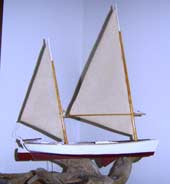 |
I enlarged the
line drawing in the article on the copier and
built a small model which still graces a spot
on a shelf in my den. |
As it happens with most of us, I happened to pick
up an issue of WoodenBoat magazine that had an eighteen
foot sharpie on the cover that rocked my world. (The
same photo that would later be used on The Sharpie
Book by Reuell Parker) There was something about that
two-masted rig that spoke to me. I could envision
myself exploring the many nooks and crannies of the
Chesapeake in such a boat. I got in touch with Bill
Schwicker, the guy who built this particular boat,
to find out if plans existed. They didn’t. Not
completely deterred, I enlarged the line drawing in
the article on the copier and built a small model
which still graces a spot on a shelf in my den. I
obsessed about that boat for a couple of years but
did not have the confidence or knowledge to build
something like that from scratch. In time, Small Boat
Journal ran an article on building a glued lapstrake
skiff that convinced me that I could build a boat.
The fiberglass racer was sold and a lovely little
boat was built. It came out really nice too, but turned
out to be better for rowing and not real comfortable
and too tender for sailing. Being a sailor, I had
to have something better.
| In time, Small Boat
Journal ran an article on building a glued lapstrake
skiff that convinced me that I could build a boat. |
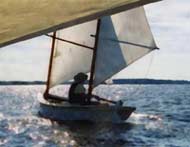
|
My 30th birthday was spent at the Calvert Maritime
Museum in Southern Maryland looking for what I hoped
would be my next boat. I had been gaining more knowledge
on traditional boats and knew that I wanted something
that was indigenous to the Chesapeake Bay. At the
end of my visit I stumbled across a small publication
in the gift shop that was entitled Crabbing Skiffs
of the Chesapeake Bay, by H.L. Chapelle. The pamphlet
was actually a reprint of two articles that were published
in Yachting magazine in the 1940’s. Of the dozen
or so line drawings in the pamphlet there was one
two-masted skiff called a two-sail bateau that was
used on the Choptank River in the early 1900’s.
That was it, this was my boat!
I bought a copy of the scale drawing that Mr. Chapelle
made from the Smithsonian Institute for the outrageous
price of something like $3.00. It was nothing more
that a scaled line drawing, no offsets. A model was
made to “build” the boat, just on a much
smaller scale to gain a little more confidence. The
benefit of building the model first is you get some
insight on what are going to be some of the more difficult
aspects of project without a total commitment to the
real job at hand. After the model is built you still
find yourself saying “Yeah, this is it!”
you can put it on the mantle to provide the inspiration
to see the project through to completion.
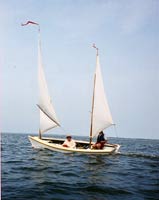 |
Of the dozen
or so line drawings in the pamphlet there was
one two-masted skiff called a two-sail bateau
that was used on the Choptank River in the early
1900’s. That was it, this was my boat! |
I had a young family and not a lot of disposable
income yet there was never any doubt that this boat
was to be built. The winds of fortune began blowing
my way. On visits to my parents’ house I always
had to check out the basement to see what new goodies
my father had procured. Dad is the ultimate scrounger.
On one visit to the old treasure chest there was a
pile of clear, vertical grain red cedar, more than
enough to build the boat. I think I bounded up the
stairs two at a time to find out what he was going
to do with the wood. It turned out that he got from
someone who was going to throw it out and naturally
he took it off their hands. “Do you want it?”
he asked. I can assure you there was no hesitation
on my end and the wood was loaded in the car faster
than a wind shift on the Chesapeake.
Dad’s find took care of my planking needs,
now how to get suitable wood for the framing? Well
the winds of fate blew once again with a phone call
from my brother. A friend of his had just bought an
old farm and the barn was full of junk that was getting
hauled into dumpsters to clear it out. In the loft
was a large pile of planks that were going to be tossed
and if I wanted a chance at them I should get over
there ASAP.
| I think I bounded
up the stairs two at a time to find out what he
was going to do with the wood. |
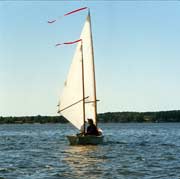
|
I left work and headed up into the country not knowing
what I would find. What was it? Would it be any good?
Had termites or beetles gotten to it? My mind was
racing. I met him there, climbed up into the loft,
and found an ample quantity of 16-foot rough sawn
cherry, maple, walnut and white oak planks which most
likely had been harvested right there off of the farm
for down in the barn was one of those big old belt
driven saws that is powered from a tractor and a large
leather belt. This was my version of hitting the lottery.
I already had a large aluminum centerboard that was
salvaged from a Comet several years before (Son of
a scrounger!) It was clear now that I was going to
be able to build the boat on the cheap. Measurements
were taken from the drawing and a preliminary table
of offsets was created, the boat lofted, and actual
measurements captured and a boat was born. Time to
build a boat!
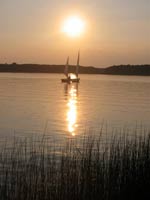 |
Measurements
were taken from the drawing and a preliminary
table of offsets was created, the boat lofted,
and actual measurements captured and a boat
was born. |
That initial trip to the museum was 14 years ago
and suffice it to say the boat was launched about
a year afterward and christened “Cinnamon Girl”
after the young gal that sailed with me on the Sailfish.
It didn’t take me long me to learn the benefits
of the cat- ketch rig. Rigging time at the ramp is
minimal. The sails are kept furled around the unstayed
masts so all that is done is set the masts, hang the
rudder and into the water she goes. She is the epitome
of the mantra “Keep It Simple”. If you
have never sailed a boat with a mizzen you don’t
know what you are missing. Haul the mizzen in tight
and tie off the tiller and she points into the wind
like a weathervane thus allowing you to easily tie
in a reef on the main, haul the anchor, go for a swim,
whatever. I have sailed the heck out of her and done
some camp sailing and she is still in top condition
and a joy to own and sail. Her roots are from the
Choptank River as I mentioned and it got it’s
name for good reason. She handles the waves like a
champ and has always brought me home. I’m not
going to lie, there have been a couple of hairy moments
and I’ve only put her over once, something about
the combination of a cleated mainsheet in gusty conditions
and no hand on the mainsheet. I’m pretty sure
that is why I capsized, what do you think?
| She handles the
waves like a champ and has always brought me home. |
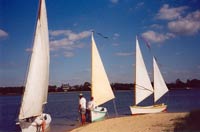
|
The cross planked bottom was replaced a couple of
years ago with 5/8ths inch marine plywood to make
her more practical as a dry sailed boat and she is
bone dry now. I’ve replaced the mainmast twice,
the first time after an encounter with overhead powerlines
at the ramp (Yikes!). The replacement was too skinny
and flexed too much which in turn spoiled the sail
shape. The current masts are clear and solid fir that
I salvaged out of the mizzen mast of a large old derelict
ketch that met her end during Hurricane Isabel.
I’ve sailed her for thirteen years now and
I must say she is one hell of a great boat. But alas,
I’ve had my eye on building something new and
have pretty much committed in my mind that I am going
to part with her, but every time I walk into the garage
and see her I have pangs of doubt. Oh, and that girl
that was with me on the Sailfish 25 years ago, she
is still by my side, my Cinnamon Girl. Not gonna’
part with her though! |